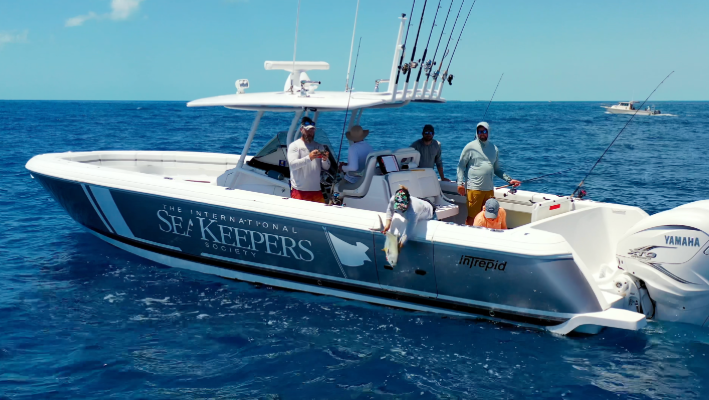Part 1: Permit Spawning Aggregation Dynamics & Predator Ecology in the Florida Keys
SeaKeepers' Vessel DISCOVERY II
Marathon, Florida
April 6 - 18, 2025
Program Overview
Each spring, permit (Trachinotus falcatus) form spawning aggregations on natural and artificial reefs throughout the Florida Keys, particularly around the full moons from March through June. In recent years, catch-and-release angling for permit during this period has become increasingly popular. While harvest is prohibited between April 1 and July 31, high levels of depredation (when predators such as sharks remove hooked fish) have raised concerns about the sustainability of this practice.
To mitigate these impacts, the Florida Fish and Wildlife Conservation Commission implemented a seasonal closure at Western Dry Rocks (WDR), a known aggregation site with historically high depredation rates.
This ongoing research project aims to evaluate permit spawning dynamics, fishing pressure, and predator interactions across multiple sites in the Florida Keys. The data collected will help inform future management decisions to ensure the long-term sustainability of the permit fishery.
Application
The data collected during this expedition will support the assessment of seasonal and annual variation in permit school size and distribution at key spawning sites throughout the Florida Keys. Observational data on recreational fishing activity will help quantify fishing effort and depredation rates at sites where angling is permitted, which is critical to understanding the impact of depredation mortality on permit spawning aggregation dynamics. Additionally, acoustic telemetry data will provide insight into the movement patterns and residency of both permit and their shark predators, contributing to broader ecological and fisheries management efforts.
Expedition Summary
From April 6 - 18, 2025, The International SeaKeepers Society supported researchers from Florida International University and Carleton University in a field expedition focused on permit (Trachinotus falcatus) spawning aggregations and associated predator interactions in the Lower and Middle Florida Keys aboard SeaKeepers' Vessel DISCOVERY II.
The research aimed to assess the ecology and relative abundance of permit, monitor fishing pressure and depredation mortality, and evaluate predator foraging behavior at known aggregation sites. Researchers used a combination of methods including video surveys and hook-and-line fishing to gather data on permit (abundance, size distribution, diet, and genetic connectivity) and potential predators (species presence, abundance, and behavior).
To track permit movement and residency, individual fish were tagged with acoustic transmitters, and underwater receivers were deployed at known aggregation sites. Researchers also collected observational data on fishing activity, such as the number of boats present, time spent fishing, and instances of hooked permit being taken by predators.
Highlights from the expedition include:
- Initial video survey results showed the highest permit abundance at Western Dry Rocks in the Lower
Keys. In the Middle Keys, permit schools were more variable and sometimes mixed with other jack
species, including crevalle and horse-eye jacks. - Permit sizes ranged from 53 to 77 cm fork length, with an average around 65 cm, consistent with
previous years. - Thirty-three permit were acoustically tagged, with 20 in the Middle Keys and 13 in the Lower Keys. Two
acoustic receivers in the Middle Keys were also downloaded and redeployed to support ongoing
tracking efforts. - Researchers collected 29 cloacal swabs to analyze fecal DNA for diet assessment and 33 fin clips to
study genetic connectivity among permit populations across Florida. - No permit fishing was observed at Western Dry Rocks, where seasonal closures were in effect.
However, targeted permit fishing was documented at sites in the Middle Keys. Most anglers spent one
to two hours on-site, and 20 angling events were recorded, with 10 fish landed. - Several shark species were observed across study sites, including great hammerhead (n=2), bull shark
(n=1), and Caribbean reef shark (n=3).
Location
Florida Keys
Duration of Project
Ongoing since 2018.
Research Team
- Florida International University: Ben Binder, Kirk Gastrich, Gina Clementi, Andrew Natter
- Carleton University: Jessica Robichaud, Luc LaRochelle
- The International SeaKeepers Society: Capt. Till Koerber


You must be logged in to post a comment.